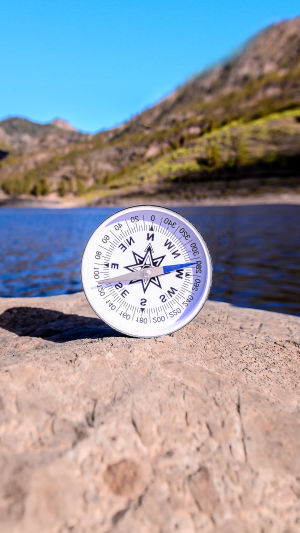Looking for an adventure, Lykkers? Navigating with a compass is an essential skill for hiking enthusiasts that can open up new paths and keep you safe in unfamiliar terrain.
Here’s a step-by-step guide to mastering compass navigation on your next hike!
<h3>1. Understand the Parts of Your Compass</h3>
The compass consists of a magnetic needle, which always points <b>north</b>, a rotating bezel marked with degrees, a baseplate, and an orienting arrow. Familiarizing yourself with these parts will help you understand how they work together to guide your direction accurately.
<b>Know Your Tools</b>: Spend time getting comfortable with each part, as this knowledge will make navigating easier when you’re out on the trail.
<h3>2. Orient the Map with Your Compass</h3>
When using a map, the first step is to orient it with your compass to align it with your surroundings. Lay the compass on the map, matching the edge with your intended route. Rotate the bezel so that north on the map and north on the compass align, making sure the compass needle points north. This setup allows you to start from a correctly oriented position, essential for accurate navigation.
<h3>3. Set Your Bearing and Direction</h3>
Once your map and compass are aligned, you’ll want to set a bearing, which is the specific direction you want to travel. Hold the compass level in front of you, with the baseplate pointing toward your destination. Turn your body until the compass needle aligns with north on the bezel. The baseplate’s arrow now shows your desired direction, giving you a clear path to follow.
<h3>4. Follow the Bearing as You Hike</h3>
As you hike, regularly check your compass to ensure you’re staying true to your bearing. Trails often wind and change direction, and natural obstacles may cause detours. Periodically aligning the needle with north on the bezel helps you stay on track and reduces the risk of veering off course.
<h3>5. Identify Landmarks Along the Way</h3>
Using landmarks like trees, mountains, or rivers can make following your bearing easier. Choose a landmark along your path to walk toward, then recheck your compass when you reach it. This technique, known as <b>leapfrogging</b>, helps break down your journey into manageable segments and makes navigation feel less overwhelming.
<h3>6. Adjust and Correct as Needed</h3>
Even with a set bearing, you may need to make adjustments due to uneven terrain or unexpected obstacles. After moving around an obstacle, recheck your bearing and adjust as needed. Regular adjustments ensure that you stay on course without straying too far from your intended path.
<h3>7. Practice Makes Perfect</h3>
Compass navigation takes time and practice to master. Before setting out on a challenging hike, practice on easier trails to build familiarity with your compass and refine your technique. Over time, you’ll gain the confidence and skills to navigate more complex terrain without hesitation.
Learning to navigate with a compass adds an empowering skill to your outdoor adventures, Lykkers! It not only enhances your safety but also opens up new possibilities for exploration. With these steps, you’re ready to embrace your next hiking journey with confidence. So go ahead, take the path less traveled, and let your compass guide the way!
How to Use a Compass || REI
The video by REI





